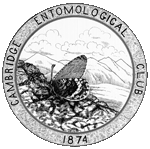
| January 2008: Psyche has a new publisher, Hindawi Publishing, and is accepting submissions |
Article beginning on page 211.
Psyche 3:211, 1880.
Full text (searchable PDF)
Durable link: http://psyche.entclub.org/3/3-211.html
The following unprocessed text is extracted from the PDF file, and is likely to be both incomplete and full of errors. Please consult the PDF file for the complete article.
PSYCHE. 21 1
CAMBRIDGE, MASS., MAY 1881.
Comdcations, excha?zges and editors' copies should be addressed to EDITORS OF PSYCHE, CWL- bridge, Mass. Commz~nications for ptt'blicaiion in P~YCHE must be properly authenticated, and no anony mous articles will be pu6Zished.
Editors and contributors are o?dy responsible for the statements wade in their own communications. Works on subjects not related to entomology will not be reviewed in P~YCHE.
For rates of subscription and of advertising', see advertising columns.
PROCEEDINGS OF SOCIETIES.
WE find in the Edomologische Nachrichten for I April 1880, Jahrg. 6, p. 65-79, a notice of the meeting entitled above, by M. von Hopffgarten, of Miilverstedt. The Entomo- logical section of this meeting, now four years old, is declared to be the centre of German entomological life.
After some ir-
relevant matter, and a list of the eighteen persons present, a list is given of the com- munications presented.
Dr. von Heyden, of
Frankfort, mentioned that Tournier had
found a species of Laccotitis, which he named themarz'us, in a hot spring, of temperature 474-4go C., in Baden, Switzerland. Mr.
Koppen, of St. Petersburg, called attention to a bibliography of the zoology of Russia which he had published in German. Baron
von Osten-Sacken: now of Heidelberg, spoke of " Certain remarkable cases of the geo- graphical distribution of tz~nlidae," an ab-
stract of which communication
is given as
follows : -
Five species of the genus Ptycho$terina are known; one is found in the Atlantic states Chili,' one in New Zealand and one in amber. The genus Elefihantomyia is found in the Atlantic states of North America, in Califor- nia, and in amber. The genus Prochotola
is known from northern and middle Europe, North America, New Zealand, Van Dieman's Land and South Australia. Several species of the group anisomeriaa with enormously long antennae in the males occur in the
Atlantic states of North America and similar species are still found in amber. The rather frequent contact of the [eastern] North
American fauna with that of the
amber, on
the one hand, and that of California, Chili and Australia, on the other hand, is especially worthy of note. as is also the circumstance that in certain genera of diptera sporadic occurrence is more frequent than it is in the other orders of insects. Considerable discussion followed this communication, in- volving the question of the geographical distribution of cave-insects.
Several ingenious pieces of collecting ap- paratus w;re exhibited, and methods of cap- ture were discussed. Five sessions were held. Baron von Osten-Sacken proposed that a
loan-library should be formed, for the benefit of entomologists, from which any one might obtain books without fee. He offered, in case such a library were established, to pre- sent to it about 300 works treating of diptera, mostly separates. Dr. Noll, of Frankfort, said that such a library, containing works on malacozoology, had already been established at Frankfort-on-Main, and that it would be a good plan to choose that city for the locale of this new library. This, together with other propositions that were brought forward at the final session, was referred to the meet- ing to be held in 1880.
A notice is given further of collections ex- amined and excursions made, and the author concludes with an expression of exultation that the entomologists felt strong enough to resist the attempt of the zoologists to swallow their section.
It was determined to hold the next meeting of North America, one in California, one in 18-24 Sept. 1880, in Danzig.
B: P. M.
================================================================================
Volume 3 table of contents